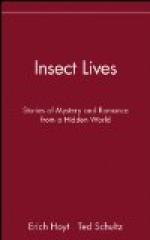[4] The convenient term ‘instar’ has been proposed by Fischer and advocated by Sharp (1895) for the form assumed by an insect during a stage of its life-story. Thus the creature as hatched from the egg is the first instar, after the first moult it has become the second instar, and so on, the number of moults being always one less than the number of instars.
[Illustration: Fig. 5. Nymph of Locust (Schistocera americana) with distinct wing-rudiments. After Howard, Insect Life, vol. VII.]
The changes through which these insects pass are therefore largely connected with the development of the wings. It is noteworthy that in an immature cockroach the entire dorsal cuticle is hard and firm. In the adult, however, while the cuticle of the prothorax remains firm, that of the two hinder thoracic and of all the abdominal segments is somewhat thin and delicate on the dorsal aspect. It needs not now to be resistant, because it is covered by the two firm forewings, which shield and protect it, except when the insect is flying. There are, indeed, slight changes in other structures not directly connected with the wings. In a young grasshopper, for example, the feelers are relatively stouter than in the adult, and the prothorax does not show the specifically distinctive shape with its definite keels and furrows. Changes in the secondary sexual characters may also be noticed. For instance, in an immature cockroach both male and female carry a pair of jointed tail-feelers or cercopods on the tenth abdominal segment, and a pair of unjointed limbs or stylets on the ninth. In the adult stage, both sexes possess cercopods, but the males only have stylets, those of the female disappearing at the final moult.
Reviewing the main features of the life-story of a grasshopper or cockroach, we notice that there is no marked or sudden change of form. The newly-hatched insect resembles generally its parent, except that it has no wings. Wing-rudiments appear, however, in an early instar as visible outgrowths on the thoracic segments, and become larger after each moult. All through its various stages the immature insect—nymph as it is called—lives in the same kind of situations and on the same kind of food as its parent, and it is all along active and lively, undergoing no resting period like the pupal stage in the transformation of the butterfly.




